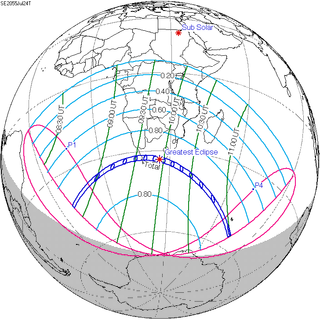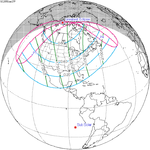Solar eclipse of July 24, 2055
| Solar eclipse of July 24, 2055 | |
|---|---|
 Map | |
| Type of eclipse | |
| Nature | Total |
| Gamma | -0.8012 |
| Magnitude | 1.0359 |
| Maximum eclipse | |
| Duration | 197 sec (3 m 17 s) |
| Coordinates | 33°18′S 25°48′E / 33.3°S 25.8°E |
| Max. width of band | 202 km (126 mi) |
| Times (UTC) | |
| Greatest eclipse | 9:57:50 |
| References | |
| Saros | 127 (60 of 82) |
| Catalog # (SE5000) | 9631 |
A total solar eclipse will occur on July 24, 2055. A solar eclipse occurs when the Moon passes between Earth and the Sun, thereby totally or partly obscuring the image of the Sun for a viewer on Earth. A total solar eclipse occurs when the Moon's apparent diameter is larger than the Sun's, blocking all direct sunlight, turning day into darkness. Totality occurs in a narrow path across Earth's surface, with the partial solar eclipse visible over a surrounding region thousands of kilometres wide.
Related eclipses[]
Solar eclipses 2054–2058[]
This eclipse is a member of a semester series. An eclipse in a semester series of solar eclipses repeats approximately every 177 days and 4 hours (a semester) at alternating nodes of the Moon's orbit.[1]
| Solar eclipse series sets from 2054-58 | ||||
|---|---|---|---|---|
| Ascending node | Descending node | |||
| Saros | Map | Saros | Map | |
| 117 | August 3, 2054 Partial |
122 | January 27, 2055 Partial | |
| 127 | July 24, 2055 Total |
132 | January 16, 2056 Annular | |
| 137 | July 12, 2056 Annular |
142 | January 5, 2057 Total | |
| 147 | July 1, 2057 Annular |
152 | December 26, 2057 Total | |
| 157 | June 21, 2058 Partial | |||
Saros 127[]
It is a part of Saros cycle 127, repeating every 18 years, 11 days, containing 82 events. The series started with partial solar eclipse on October 10, 991 AD. It contains total eclipses from May 14, 1352 through August 15, 2091. There are no annular eclipses in this series. The series ends at member 82 as a partial eclipse on March 21, 2452. The longest duration of totality was 5 minutes, 40 seconds on August 30, 1532. All eclipses in this series occurs at the Moon’s ascending node.[2]
| Series members 52–68 occur between 1901 and 2200 | ||
|---|---|---|
| 52 | 53 | 54 |
 April 28, 1911 |
 May 9, 1929 |
 May 20, 1947 |
| 55 | 56 | 57 |
 May 30, 1965 |
 June 11, 1983 |
 June 21, 2001 |
| 58 | 59 | 60 |
 July 2, 2019 |
 July 13, 2037 |
 July 24, 2055 |
| 61 | 62 | 63 |
 August 3, 2073 |
 August 15, 2091 |
August 26, 2109 (Partial) |
| 64 | 65 | 66 |
| September 6, 2127 (Partial | September 16, 2145 (Partial) | September 28, 2163 (Partial) |
| 67 | 68 | |
| October 8, 2181 (Partial) | October 19, 2199 (Partial) | |
References[]
- ^ van Gent, R.H. "Solar- and Lunar-Eclipse Predictions from Antiquity to the Present". A Catalogue of Eclipse Cycles. Utrecht University. Retrieved 6 October 2018.
- ^ "Solar Saros series 127". NASA Goddard Space Flight Center. NASA. Retrieved 2 November 2017.
External links[]
- Total solar eclipses
- 2055 in science
- 21st-century solar eclipses
- Future solar eclipses
- Solar eclipse stubs



